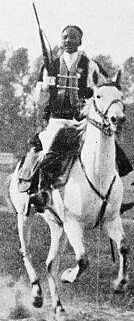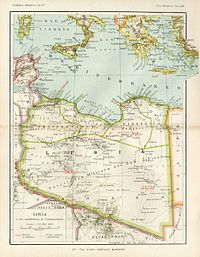Savari

Savari was the designation given to the regular Libyan cavalry regiments of the Italian colonial army in Tripolitania and Cyrenaica. The word "savari" was derived from a Persian term for "horsemen" ( Savārān ) .
Organisation
This cavalry force was recruited from the Arab-Berber population of what is now Libya, following the Italian occupation in 1911-12. The first Savari units were raised in December 1912. The officers of the fourteen squadrons (twelve designated as "regular line" and two as "command") comprising this corps were nearly all Italian. Their troopers and some of the non-commissioned officers were Berber and Arab volunteers, who had a long tradition of horsemanship.
Seven line squadrons were recruited from Tripolitania and five from Cyrenica during the 1920s and 1930s.[1]
Uniforms
Each squadron was distinguished by a distinctively coloured sash and farmula (sleeveless jacket) worn with white or khaki uniforms according to occasion. Sash and farmula colours were yellow, black, crimson, blue, green, red and orange, worn in various combinations according to the unit. Dark red "tachia" fezs of traditional Libyan pattern were worn by all Muslim personnel over white skull caps.
History
The Savari formed part of the Regio Corpo Truppe Coloniali della Libia (Royal Corps of Libyan Colonial Troops or RCTL), which included desert and camel troops, infantry battalions, artillery and irregular cavalry (called "Spahis").
The Truppe Coloniali saw extensive service during the Italian conquest of Cyrenaica, which was not completed until 1932. Rebel leader Omar Al Mukhtar was captured by a Libyan Savari of the Italian colonial troops [2] in 1931.
In 1936 Savari and other Libyan units took part in the Italian invasion of Ethiopia and received a "Gold Medal of Honor" for their performance in battle [3]
Savari commander
Amedeo Guillet was the commander of the VII°Savari Squadron in 1937. He was recognized for improving relations with the Libyan populace and charged with organising the equestrian part for the celebrations (during which the “sword of Islam” was unsheathed) of Benito Mussolini's visit to Libya in 1937 [4]
World War II
On the eve of Italy's entry into World War II the Royal Corps of Libyan Colonial Troops comprised approximately 28,000 locally recruited personnel. They suffered heavy losses during the Battle of the Marmarica (December 1940).
The RCTL was formally disbanded in January 1943 following the Italian withdrawal into Tunisia. Prior to this the role of the Savari and other mounted troops had been restricted to patrol and scouting work in the desert frontier regions of the Libyan interior, by the demands of modern mechanised warfare.
References
- ^ Paolo Marzetti, "Uniformi e Distintivi dell" Escercito Italiano 1933-1945", Tuttostoria 1981
- ^ Quirico, Domenico. "Lo squadrone bianco", p.313 : "Omar Al Mukhtar was captured by a group of Libyan Savari....He fell from his horse and a Libyan savari was going to shoot him....but he screamed 'I am Omar el Mukhtar' and so was recognized and captured" (A catturare Omar al-Mukhtar fu uno squadrone di altri libici che servivano nei nostri reparti a cavallo... Fu pura fortuna, perché il destriero di quel vecchio guerriero nella fuga inciampò facendo cadere a terra il suo padrone. L'uomo aveva un fucile a tracolla a sei cartucce, ma essendo ferito a un braccio non riusciva a puntare la sua arma. Il libico che vestiva la nostra divisa puntò il fucile e stava per sparare, non c'era pietà in quella guerra fratricida. Si fermò quando l'uomo lanciò un grido: "Sono Omar el Muchtàr).
- ^ Medal of Military Honor
- ^ Video with Savari images
Sources
- "Le Uniformi Coloniali Libiche 1912 - 1942" Priero Crocaini and Andrea Viotti.
- "Inside Africa" John Gunther
- "World Armies" John Keegan ISBN 0-333-17236-1


